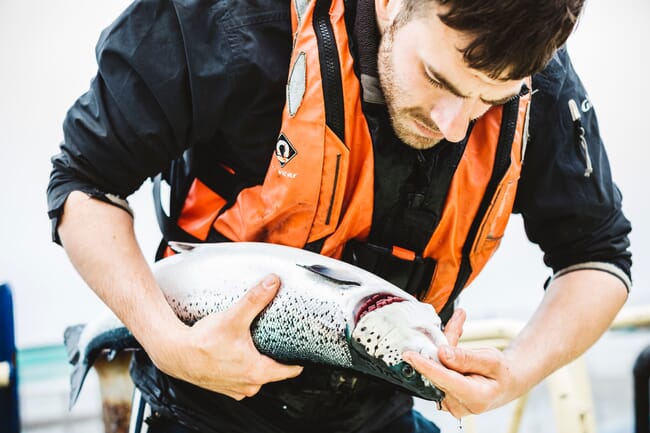Figures for both salmon farmers show that the number of fish that died as a result of disease fell by over 50 percent between January and May compared with the previous six months.

© Scottish Sea Farms
Disease-related mortality is also lower year on year, with Marine Harvest Scotland and Scottish Sea Farms reporting a reduction of 61 percent and 27 percent respectively compared with the first six months of 2017.
The sustained improvement comes as welcome news following a challenging year for some farms owing to warmer than average sea surface temperatures, leading to an increase in blooms of harmful algae and jellyfish.
In response, both producers have invested in new technologies including:
- Environmental data monitoring equipment enabling real-time analysis of key markers such as salinity and oxygen concentration, helping farmers make swift and informed decisions.
- Underwater camera systems enabling farmers to observe salmon within the pens and respond quickly to any changes in innate behaviour.
- Innovative new netting which, in initial pilots, has helped eliminate gill disease.
Changes have also been made to farm management strategies.
Meritxell Diez Padrisa, head of fish health at Marine Harvest Scotland, says: “Each individual farm effectively has its own micro-environment and therefore faces its own challenges. However, by taking a tailored approach to farm management that is based on the local marine ecosystem and has prevention at its core, we have been able to increase the protection offered to the salmon in our care.”
Both producers are also investing in multi-million pound state-of-the-art hatcheries which will enable smolts to be grown to a larger, more robust size, thereby shortening their exposure to potentially harmful marine organisms.
Meanwhile, adding to the improvement in overall fish health, Marine Harvest Scotland experienced a 49 percent drop in sea lice levels compared with the previous six months, while the levels at Scottish Sea Farms fell by 34 percent.
Ralph Bickerdike, Head of Fish Health at Scottish Sea Farms, explains: “Colder temperatures witnessed over winter 2017 have some part to play in this reduction, helping slow the growth of sea lice. However, we’re also seeing the cumulative impact of investment in integrated sea lice management including sea lice shields which reduce the number of lice entering salmon pens in the first place, use of cleaner fish which eat sea lice, and hydro and thermolicer technology which washes off and collects sea lice. The result of these efforts is that we’re seeing some of our healthiest, strongest fish yet.”
The results are equally encouraging across the sector as a whole, with Scottish Salmon Producers’ Organisation (SSPO) figures showing that sea lice levels are at their lowest since July 2013.
Helping to ensure these positive trends in fish health are maintained will be the recently announced Scotland’s 10 Year Farmed Fish Health Framework - a joint initiative between Scotland’s salmon and trout farmers, the Scottish Government and several of its agencies - which sets out a number of key measures for the sustainable growth of the sector, including improving gill health and reducing sea lice numbers.



